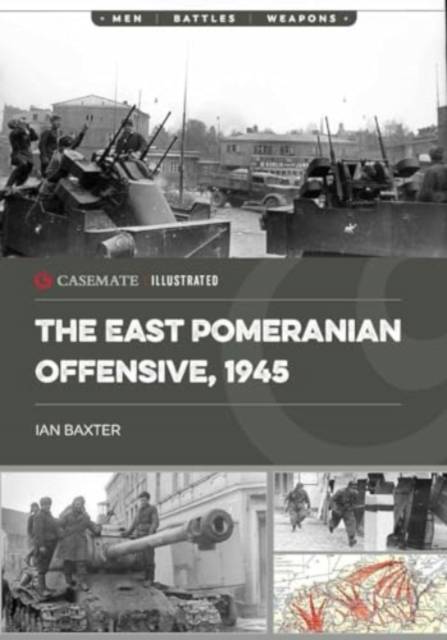
- Retrait gratuit dans votre magasin Club
- 7.000.000 titres dans notre catalogue
- Payer en toute sécurité
- Toujours un magasin près de chez vous
- Retrait gratuit dans votre magasin Club
- 7.000.000 titres dans notre catalogue
- Payer en toute sécurité
- Toujours un magasin près de chez vous
The East Pomeranian Offensive, 1945
Destruction of German Forces in Pomerania and West Prussia
Ian Baxter
34,95 €
+ 69 points
Description
"If you are a fan of late war Russian and German equipment and the offensives that destroyed the Reich, this is a great reference. The photos provided give a good glimpse at the power of the Russian army at the end of the war and the desperation of the German defense of the Homeland." - AMPS
In early 1945, the Red Army marched into East Prussia. Having advanced across Poland, relentlessly pushing back German forces, the Red Army built up forces along the Oder River, preparing for the final push towards Berlin. But before that battle could take place, it was necessary to clear and destroy German forces in Pomerania and West Prussia. In February 1945, the 2nd Byelorussian Front was advanced west north of the Vistula River toward Pomerania and the major port city of Danzig, with the primary aim of protecting the right flank of Zhukov's 1st Byelorussian Front, which was pushing towards Berlin. The opening of the offensive saw a series of heavy attacks east of Neustettin against the towns of Kontiz and Koslin. The fighting was bitter, resulting in the entire left wing of the 3rd Panzer Army being cut off.
Forward Soviet tank units reached the Baltic, and the German forces in Pomerania became trapped in a series of encirclements. Russian troops then pushed on to Danzig--strategic location and the last German stronghold in the region--reaching it in early March and putting it under siege. A third stage was the operation to take the Arnswalde and Kolberg areas. Kolberg was one of the key German positions in the "Pomeranian wall," the vital link between Pomerania and Prussia. The German high command had planned to use the port facilities for the logistical supply of nearby German forces, and hoped that the presence of this stronghold would lure Soviet forces away from the main thrust toward Berlin. The ensuing battle was brutal, with Soviet troops eventually seizing Kolberg. Finally, spearheads of the 1st Byelorussian Front advanced against the German Eleventh SS Panzer Army, which was being assembled in Pomerania. What followed was a bitter and bloody battle for the town of Altdamm.
The offensive successfully cleared the remnants of German forces northeast of Berlin, allowing Zhukov's forces to finally launch the battle of Berlin from the Seelow Heights on the Oder on April 16, 1945.
In early 1945, the Red Army marched into East Prussia. Having advanced across Poland, relentlessly pushing back German forces, the Red Army built up forces along the Oder River, preparing for the final push towards Berlin. But before that battle could take place, it was necessary to clear and destroy German forces in Pomerania and West Prussia. In February 1945, the 2nd Byelorussian Front was advanced west north of the Vistula River toward Pomerania and the major port city of Danzig, with the primary aim of protecting the right flank of Zhukov's 1st Byelorussian Front, which was pushing towards Berlin. The opening of the offensive saw a series of heavy attacks east of Neustettin against the towns of Kontiz and Koslin. The fighting was bitter, resulting in the entire left wing of the 3rd Panzer Army being cut off.
Forward Soviet tank units reached the Baltic, and the German forces in Pomerania became trapped in a series of encirclements. Russian troops then pushed on to Danzig--strategic location and the last German stronghold in the region--reaching it in early March and putting it under siege. A third stage was the operation to take the Arnswalde and Kolberg areas. Kolberg was one of the key German positions in the "Pomeranian wall," the vital link between Pomerania and Prussia. The German high command had planned to use the port facilities for the logistical supply of nearby German forces, and hoped that the presence of this stronghold would lure Soviet forces away from the main thrust toward Berlin. The ensuing battle was brutal, with Soviet troops eventually seizing Kolberg. Finally, spearheads of the 1st Byelorussian Front advanced against the German Eleventh SS Panzer Army, which was being assembled in Pomerania. What followed was a bitter and bloody battle for the town of Altdamm.
The offensive successfully cleared the remnants of German forces northeast of Berlin, allowing Zhukov's forces to finally launch the battle of Berlin from the Seelow Heights on the Oder on April 16, 1945.
Spécifications
Parties prenantes
- Auteur(s) :
- Editeur:
Contenu
- Nombre de pages :
- 128
- Langue:
- Anglais
- Collection :
Caractéristiques
- EAN:
- 9781636243887
- Date de parution :
- 31-01-25
- Format:
- Livre broché
- Format numérique:
- Trade paperback (VS)
- Dimensions :
- 174 mm x 252 mm
- Poids :
- 417 g







